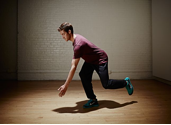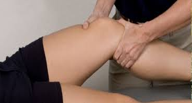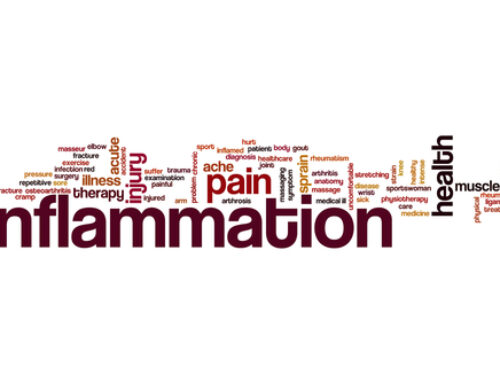Eric, a friend of a patient, wrote me recently thanking me for helping him run his last marathon at a personal best time (3:38)! The funny thing is, I have never met Eric. He just took the same advice I have given many runners over the years: run less, run faster, get stronger, and improve mobility.
The story Eric wrote me was similar to scores of patients we have seen over the past 10 years. Eric described his knee pain as being fine with short runs, but the anterior and lateral pain was occurring after 30+ minutes of jogging. Presumably, as fatigue sets in, running mechanics/efficiency change, and pain kicks in. But why? How can a runner feel fine at the beginning of a run and then have pain at that magic number of miles, time, or speed? The answer is complicated, but I have broken it down into five tips that can help you run healthier and faster:
 1. The longer you run, the less you rely on reflexive actions (storing and releasing of elastic energy in your tendons) and the more you start to muscle through the workout. This decreases the tendon reflexes in your hamstrings, which act as a “spring” to allow for conservation of energy and reducing need for muscular use. Using the body’s “springs” can create a faster, less-injury-prone runner.
1. The longer you run, the less you rely on reflexive actions (storing and releasing of elastic energy in your tendons) and the more you start to muscle through the workout. This decreases the tendon reflexes in your hamstrings, which act as a “spring” to allow for conservation of energy and reducing need for muscular use. Using the body’s “springs” can create a faster, less-injury-prone runner.
The longer you run, the more the reflexive activity decreases. This is why stretching your hamstrings prior to running is counter productive and should be avoided. Keeping your next run long enough to be an effective workout, but short enough to keep good running form is vitally important.
2. Proper running form involves upright posture, good foot strike, and proper stride length. Stride length naturally decreases the longer you exercise. This is related to both tip #1 above and to the fact that the muscles doing the propelling just aren’t conditioned to keep up the same level of force production. This lack of conditioning is related to a muscle imbalance involving the strength, mobility, and endurance of the hip muscles.
Common among too many weekend warriors is an imbalance of the hip musculature, where tightness of the hip flexor muscle (psoas) causes a decrease in the hip stabilization system. The weekend warriors who simply train with distance running, elliptical machines, or stair climbers are setting themselves up for failure with these training methods, as they reinforce this muscle imbalance. The cure is thought to be training longer and harder, but this could be not further from the truth. Overuse creates more injury, creating scar tissue and tightness. This reinforces the muscle imbalance and keeps the injury mechanism turning.
Strength training can be a key to help runners reduce the common muscle imbalances and improve their hip stabilization. Two-leg squats, one-leg step downs, lunges, bowler’s squats, kettle bell swings, and most other standing, functional exercises can be important for hip stabilization.
3. If you haven’t noticed, the world-record marathon time is getting closer and closer to the two-hour mark. Do the math, and you’ll realize that these guys are running 4:30 miles. That’s an average of over 12 miles per hour! This is an amazing feat. One thing for sure is that to run that fast, you have to be efficient just like a sprinter. If you look at the elite marathoners, they’re running like sprinters – on the balls of their feet and landing underneath the torso, not out in front.
Let’s look at the novice runner, though. He or she might do fine with the balls of the feet for the initial aspect of the race, but as fatigue sets in, heel-to-toe running kicks in. When you run on the balls of your feet, the compression weight at the foot is four times your body weight. This jumps up to six-times the body weight with heel-to-toe striking. Can you see how that might cause an overuse injury?
This is where footwear can make such a big difference. If you ask the layman how to minimize ground reaction forces, he’ll likely tell you to make the shoe sole thicker. Unfortunately, the research says otherwise. Studies show that the thinner the shoe, the less impact force that is created at foot strike. Why? Because runners naturally change to a more upright running posture and strike the ground in a mid-foot or fore-foot position, thus minimizing the body weight force created.
 4. Sprint training for a distance runner can help to train proper foot strike while improving hip mobilization and glute strength. Inputting days that are dedicated to short and fast intervals can save the wear and tear on a runner’s legs while improving overall times. Likewise, workouts that involve hill climbing or plyometrics can improve torque strength in the legs and improve range of motion in the ankle and knee. Combine sprint, hill-climbing, and plyometric workouts with barefoot balance training, and you can improve not only the joint mechanics, but also the nervous system’s involvement in running.
4. Sprint training for a distance runner can help to train proper foot strike while improving hip mobilization and glute strength. Inputting days that are dedicated to short and fast intervals can save the wear and tear on a runner’s legs while improving overall times. Likewise, workouts that involve hill climbing or plyometrics can improve torque strength in the legs and improve range of motion in the ankle and knee. Combine sprint, hill-climbing, and plyometric workouts with barefoot balance training, and you can improve not only the joint mechanics, but also the nervous system’s involvement in running.
Try this: Stand barefoot on one leg, and take a tennis ball in one hand. Throw the tennis ball up against a wall standing 3-5 feet from the wall. Try to catch the ball in the other hand. Advance the exercise by throwing the ball and catching it in multiple planes of elevation.
 5. Range of motion (ROM) is a key to great running. Active Release Technique (ART®) is the preferred method of choice of many of our athletes to ensure great ROM. Its ability to break up scar tissue and quickly mobilize old injuries while preventing new injuries is remarkable. After many years of performing ART®, it still continues to amaze me how quickly soft-tissue problems can be resolved, getting our athletes back out to doing what they love. Anyone who is regularly performing repetitive-motion activities is prone to scar tissue and therefore needs soft-tissue work like ART® regularly.
5. Range of motion (ROM) is a key to great running. Active Release Technique (ART®) is the preferred method of choice of many of our athletes to ensure great ROM. Its ability to break up scar tissue and quickly mobilize old injuries while preventing new injuries is remarkable. After many years of performing ART®, it still continues to amaze me how quickly soft-tissue problems can be resolved, getting our athletes back out to doing what they love. Anyone who is regularly performing repetitive-motion activities is prone to scar tissue and therefore needs soft-tissue work like ART® regularly.
The days of just running long distances to become a better runner are over. While you can have your distance work (if you’re healthy) to develop favorable aerobic adaptations and hit the anaerobic threshold while getting used to the “burn,” to be successful and healthy long-term, you need to:
a. Strength train.
b. Do mobility work.
c. Do soft-tissue work.
d. Do plyos and sprint training.
e. Do barefoot balance training.
f. Pay close attention to footwear.
Put these steps into your workout plan, and watch this year be your best running year ever.
Dr. Daryl Rich, DC, CSCS






